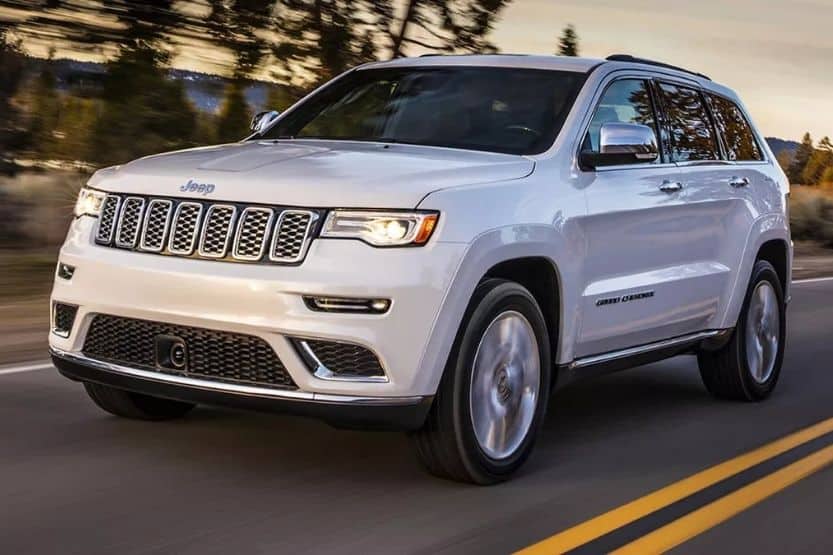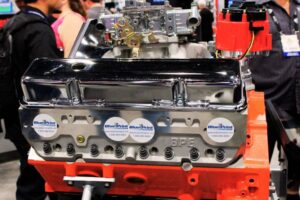Powerful and reliable but also heavy and expensive – these are some of the things that you can expect from a Hemi engine. What does Hemi mean? How did it evolve through the years?
Hemi is short for the hemispherical combustion chamber, an engine popularized by Chrysler in the 1950s. However, its humble beginnings started as early as the 1900s. It has a domed head instead of a flat head, which provides higher compression and more power.
Read on to learn more about what a hemi is, as well as its history.
What Is a Hemi Engine?

A Hemi is an informal term that refers to an engine with a hemispherical combustion chamber. Most young car enthusiasts refer to Chrysler’s engine, found in many powerful muscle cars.
However, as you will learn later, Chrysler did not invent this engine, and it existed as early as the 1900s.
One of the most notable features of a Hemi engine is that the intake and exhaust valves are on the opposite sides of a chamber. This is beneficial in improving airflow, and in turn, enhancing the performance of the engine.
The head of the Hemi’s cylinder is spherical. Imagine a grapefruit cut and hollowed in the middle. At the top center, you will find the spark plug. This strategic position minimizes the burn distance of the air and fuel mixture.
A Brief History of Hemi Engines
After talking about what a Hemi is, let’s have a quick look at its colorful past. Many people will associate Hemi with the engine from Chrysler. While the company popularized and revolutionized the Hemi, they did not invent it. Other car manufacturers utilize the Hemi engine as well.
The earliest iteration of the Hemi engine was in 1905 by Pipe, a Belgian car manufacturer. It has a four-cylinder design back then. In 1907, the Fiat 130HP Grand Prix race car used this engine.
It did not take long before different manufacturers followed suit and introduced their Hemi engines with astounding benefits. These companies include Alfa Romeo, Peugeot, and Daimler. Production halted because the engine was expensive to make.
The Hemi was also prominent during World War II, specifically in the military and aeronautic applications. P45 fighter aircraft to M47 tanks used Hemi engines due to their power.
It was after World War II when the Hemi engine made a comeback in the consumer car market. Despite many manufacturers dropping the Hemi in their cars because of the increasing price, Chrysler initiated the rebirth.
The Imperial, Saratoga, and New Yorker were the first cars with the Chrysler Hemi engines. It was groundbreaking, and the company has introduced two more iterations of the engine.
Three Generations of the Hemi Engine from Chrysler
It is almost impossible to talk about Hemis without mentioning Chrysler. Chrysler revolutionized and popularized the Hemi globally. From the 1950s to the present, Chrysler produced three generations of the Hemi engine:
First Generation
It was in 1951 when the first Chrysler engine hit the global market. The overhead-valve V8 engine replaced the conventional flathead design. The cast-iron engine was called FirePower, which has a power of 180HP and 312 lb-ft of torque.
From 1951 to 1958, the first-generation Chrysler engine had several improvements and innovations. The initial exhaust headers were streamlined to improve volumetric efficiency, increasing power to up to 193 HP and 330 lb-ft of torque.
The exhaust valves’ size and performance also had improvements, adding four inline carburetors on the top of the engine to enhance performance.
Research and improvements continued until the introduction of the C-300 in 1955. The 331-cubic-inch engine by Bob Rodger had 340 or 355 HP. This was the first American-made passenger car with horsepower surpassing the 300-mark.
By 1958, the Chrysler Hemi engine already reached 380 HP. The production stopped a year after.
Second Generation
After over five years, Chrysler re-introduced the Hemi engine. In 1964, Chrysler trademarked the name Hemi.
Also called the elephant engine, the 426 Hemi was known for its power and size. With a deck height of 10.72 inches and bore spacing of 4.8 inches, it was the largest engine in a race car at that time.
The second-generation Hemi engine was also the one used in NASCAR. It was initially manufactured strictly for race cars. Plymouth Fury, Dodge Dart, and Dodge Coronet used this engine.
One of the turning points in the history of the Hemi engine in the racing community was when Richard Petty won in the 1964 Daytona 500 driving a Plymouth Belvedere. The second and third finishers of the race were using cars with Hemi engines too.

However, the short-lived fame of the Chrysler Hemi in NASCAR was cut short in 1965. It was banned from the competition because of its unavailability. There were also complaints about the fair advantage of the Hemi engine.
In 1966, Chrysler introduced the street Hemi, making the engine more accessible to the general public. It was similar to the engines in race cars but had lower technical specifications. It still had a high RPM but came with new inline aluminum twin four-barrel carburetors.
Compared to the Hemi race versions, the street variant required minimal maintenance and handled different weather conditions.
Third Generation
The third-generation Chrysler engine was introduced in 2003 following a three-decade hiatus. It was called the NEW HEMI engine in all caps, emphasizing its monstrous performance.
While the first and second-generation Hemi engines were exclusive high-performance cars, the third-generation was more accessible. It has impressive power available to everyone.
The 2003 5.7-liter V8 Hemi engine had almost perfect hemispherical combustion engines. It has improved fuel injection and sparks advance, resulting in better efficiency.
In 2005, The Street and Racing Technology division of Chrysler introduced the 6.1-liter Hemi. It had a remarkable power of 425 HP and torque of 420 lb-ft. with lightweight pistons and enhanced engine block. It was pretty impressive, considering it was built for passenger cars.
In 2007, Chrysler presented another iteration of the Hemi engine. This time, it was the 6.4-liter Apache engine with 525 HP and 510 lb-ft of torque.
Again, what does Hemi mean? Hemi is short for the hemispherical combustion chamber, an engine that Chrysler popularized in the 1950s. However, its beginnings started as early as the 1900s.
It has a domed head instead of a flat head, which provides higher compression and more power.
Pros and Cons of a Hemi Engine
With its reputation amongst car enthusiasts, is a Hemi engine really as good as how it claims? Are there any drawbacks?
The Good
Over the years, the Hemi engine has made a name because of its many benefits, including the following:
1. It Is Powerful
The power of the Hemi is its best asset. This is the main reason why it is the preferred choice for muscle cars over the years. The shape of the valve allows the combustion to rise quicker, burning the fuel in a shorter window compared to a traditional engine.
This short pressure buildup enhances the power stroke. The engine has a high compression ratio that delivers more power.
2. It Is Reliable
A good Hemi engine is a long-term investment. Anyone who owns a car with this engine will surely agree. It is built to perform without requiring too much from the owner. It isn’t fool-proof, but it does not experience problems as often as other engines.
3. It Improves Airflow
Airflow directly impacts the performance of the engine. A Hemi is beneficial because of the size and location of the valves. They are on the opposite sides of the chamber.
As a result, more air enters, and more exhaust exits. The engine tips the valves sideways to remain compact while improving airflow.
The Bad
Despite all the good things, Hemi engines are far from perfect. Here are some of its most notable drawbacks:
1. It Has Limited Valves
One of the biggest problems with a Hemi engine is its design allows it to have two valves, limiting its peak performance. Having four smaller valves will let a car breathe more, and that is not one thing that you will experience with a Hemi.
2. It Is Heavy
The design of the Hemi engine makes it heavier compared to a traditional engine. This adds weight to the car unless other components are offset.
3. It Is Not Fuel-Efficient
If you are looking for fuel efficiency, then a Hemi engine is not for you. Given its powerful performance, it follows that fuel efficiency and gas mileage are not its best assets.
Notable Cars and Trucks with a Hemi Engine
From sedans to trucks, the Hemi engine is available in different vehicles these days. The Hemi engines you will see in today’s cars are third-generation designs, delivering a displacement of 5.7 to 6.4 liters and performance of 360 to 707 HP.
1. Dodge Challenger SRT Hellcat
This is one of the most beautiful Hemi cars available today with its classic design and modern power. Built for speed and performance, it has a 6.20-liter V8 Hemi engine with 717 HP. With its engine, the car goes from zero to 60 mph in less than three seconds.
Price: $58,995
2. Dodge Charger SRT Hellcat
The most powerful and fastest mass-produced sedan in the world – this is the Dodge Charger SRT Hellcat’s claim to fame. The car’s exceptional performance is possible because of its 6.2-liter high-output V8 Hemi engine. It takes only 3.6 seconds for the car to reach 60 mph.
Price: $69,995
3. Chrysler 300
Fuel economy is one of the most common complaints about the Hemi engine, which is also a problem in other high-performance engines. If you are looking for better fuel efficiency, the Chrysler 300 is an excellent option.
It comes with a 5.7-liter Hemi V8 engine with an industry-leading 363 HP and 394 lb-ft of torque. An all-wheel-drive version is available so that you can enjoy exceptional control in all environments.
Price: $30,040
4. Ram 1500 4WD
For a four-wheel drive that offers exceptional fuel economy, you cannot go wrong with the RAM 1500. Built for city driving, it has an average consumption of 15 mpg in the city and 21 mpg on the highway.
Price: $43,340
5. Dodge Durango
With a 6.2-liter Hemi SRT Hellcat V8 engine, this car delivers a whopping 710 HP and 645 lb-ft of torque. It has a towing capacity of 8,700 pounds, indicative of its incredible strength on the road. This SUV is a muscle masterpiece with a menacing style.
Price: $31,995
6. Jeep Grand Cherokee

A multi-awarded SUV, the 2020 Grand Cherokee has a 6.2-liter Hemi V8 engine, which delivers 707 HP and 645 lb-ft of torque. From Quadra-Lift System to Hill Ascent Control, this is a competent off-road vehicle, perfect even for the most discerning buyers.
Price: $34,200
7. Chrysler 300C Platinum RWD
For those in the market for luxury cars, this model comes with a 5.7-liter Hemi V8 engine.
It has many luxurious features, including remote proximity, keyless entry, auto-dimming rearview mirror, heated steering wheel, ventilated front seats, and automatic headlamp leveling system.
Price: $42,770
8. RAM 1500 Tradesman
This is one of the best cars worth considering if budget is an issue. Despite being cheap, it has a powerful performance with a 5.7-liter engine. It has 395 HP and 410 lb-ft of torque. This is lower than the other cars on this list, but it is unbeatable when it comes to the price to performance ratio.
Price: $24,395
Conclusion – What Is a Hemi? What Does Hemi Mean?
By now, we hope that you learned a thing or two in the discussions above about what is a Hemi engine. Hemi stands for the hemispherical combustion chamber, an engine first introduced in the 1900s but was revolutionized and popularized by Chrysler in the 1950s.
From its power to its reliability, muscle car fans praised the Hemi engine. Nonetheless, there were also some issues, such as its price and weight. Despite these problems, it is one of the best and most powerful engines to date.
Related reading:
5.7 Hemi Problems [Dodge 5.7 Hemi Causes and Solutions]

![5.7 Hemi Problems [7 Most Common] 5.7 Hemi Problems](https://roadsumo.com/wp-content/uploads/2021/11/5.7-Hemi-Problems-150x150.jpg)

![Interference Engine List [and Non-Interference Engine List] interference engine list](https://roadsumo.com/wp-content/uploads/2021/06/interference-engine-list-150x150.jpg)


![DRL Warning Light [What Does It Mean, Causes, and How to Fix] what does the drl warning light mean](https://roadsumo.com/wp-content/uploads/2022/04/what-does-the-drl-warning-light-mean-150x150.jpg)
![Read more about the article Duramax Years to Avoid [Worst Duramax Engines]](https://roadsumo.com/wp-content/uploads/2022/05/Duramax-years-to-avoid-300x200.jpg)
![Read more about the article Crankshaft Position Sensor [Symptoms, Location, Replacement]](https://roadsumo.com/wp-content/uploads/2021/04/crankshaft-position-sensor-300x200.jpg)
